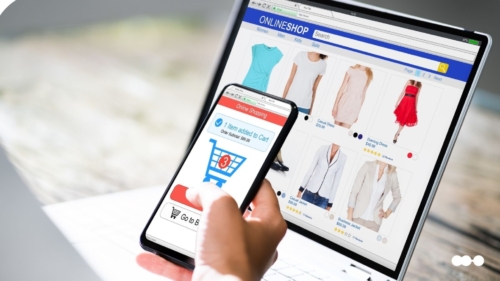ARTICLE SUMMARY
A customer satisfaction survey is the instrument that helps companies measure their customers level of satisfaction with their product/service.

What is a customer satisfaction survey?
A customer satisfaction survey, or a CSAT survey, is a questionnaire used by companies to understand how satisfied customers are with its branding, products, services, or customer support experience.
In addition to the positives, companies are also interested in learning more about opportunities for improvements that benefit both the company and customers, including:
- Identifying and resolving common process bottlenecks that negatively affect customer experiences
- Creating better customer experiences
- Developing ideas for improvements or new products/services
- Finding brand advocates to help promote the company
Overall, the purpose of customer satisfaction surveys is to gather customer feedback that can be used to improve the overall customer experience — from the products/services a company offers to the business processes that work toward supporting customer satisfaction.
What does a customer survey satisfaction survey look like?
This varies depending on the information that’s being collected, how it’s being collected, why it’s being collected, and the level of detail that is needed.

For example, following a customer support call, a company may send a digital survey asking how well the service was rated from one to five (one being poor and five being excellent). If the answer is one (or poor), then the company may request a call for more information.
A customer satisfaction survey can come in the form of:
- A digital survey shared via email after a customer support call to determine how satisfied they were with the help they received, or after a dining experience at a restaurant.
- A print survey for real-time product testing and customer feedback at experiential events or demos.
- A phone survey that’s conducted directly after a customer support call or as a follow-up to a dissatisfactory customer experience.
- A push notification survey that engages with customers directly via text messages. Customers have to opt-in to receive these notifications, and they can be used as part of a nurture campaign to improve customer engagement and satisfaction.
Types of satisfaction surveys and question examples
Depending on what you’re interested in learning about, there are various types of questions that can be asked. It’s common for various types of questions to be used together so as to gain the most accurate and detailed customer feedback. Below are examples of the types of surveys, questions, and the sort of knowledge that they collect.
Product usage survey
Product usage questions or product surveys are used to learn more about a customer’s experience and satisfaction with a product. This product feedback is necessary for understanding what customers are thinking and how they feel about the product.
Product usage question examples
- How often do you use our product?
- Is the product useful?
- How easy is our product to use?
- How can the product be better? What features are missing from the product?
- Do you think the product is valued at the right price point?
- How likely are you to recommend this product to a friend or family member?
Demographics survey
These types of customer surveys are used to learn more about the buyer, specifically the qualities and specific characteristics of this population. This information can help improve the way you target potential customers, which is beneficial to the marketing and sales team.
Demographics question examples
- What is your age?
- What gender do you identify as?
- What country do you live in?
- What state do you live in?
- Are you married?
- What is the highest degree or level of education you have completed?
Psychographics survey
Similar to demographic customer surveys, psychographic surveys are also used to better understand customers. However, this type of survey is related to psychological criteria, such as emotions, values, lifestyle, and attitudes. This data is useful for targeting potential customers that align with your brand’s or company’s values or interests and learning how to speak to them better.
Psychographics question examples
- How do you feel about our product?
- How do you feel about our brand?
- On a scale of 1 to 5, how likely are you to purchase from a brand that aligns with your personal values?
Satisfaction scale survey
This type of customer survey is ideal for understanding customer satisfaction with your product or service. This type of survey will resemble a scale, and customers will be asked to select a number on the scale that best describes their satisfaction or experience.
It’s common to have customers respond to satisfaction scales following any form of customer support, whether it’s a phone call or a live online chat with a customer service representative.
Using scales to measure customer satisfaction makes it a lot more practical to measure changes in satisfaction over time. That’s even more important when trying to measure the impact of a specific initiative.
Example: On a scale of one to five, how would you rate your customer service experience on [date] with [customer representative]?
| 1 | 2 | 3 | 4 | 5 |
|---|---|---|---|---|
| Extremely Dissatisfied | Dissatisfied | Neutral (neither satisfied nor dissatisfied) | Satisfied | Extremely satisfied |
Example: On a scale of one to five, how likely are you to recommend our service to a friend or family member?
| 1 | 2 | 3 | 4 | 5 |
|---|---|---|---|---|
| Extremely unlikely | Unlikely | Neutral (neither likely nor unlikely) | Likely | Extremely likely |
Open-text survey
Open-text or open-ended questions are used to collect additional details and allow customers to go more in-depth with their responses. Due to the challenging nature of tracking these sorts of responses, open-text questions are more likely to be used to supplement additional questions. For example, if a customer answers a satisfaction scale question with 1 or 2, which indicates a poor customer experience, an open-text question lets them provide more detail to help understand their response.
Open-text boxes can be included at the end of a survey to gather additional comments or feedback, or they can be automatically triggered when a customer responds a certain way.
Open-text question examples
How would you rate your customer service experience on [date] with [customer representative]?
- Extremely satisfied
- Satisfied
- Neither satisfied nor dissatisfied
- Dissatisfied
- Extremely satisfied
Let’s assume the customer selected dissatisfied or extremely dissatisfied. In that case, an open-text answer box will populate for additional information, such as:
Example: We’re sorry that you weren’t satisfied with your recent customer experience. Please elaborate on why you were dissatisfied to help us improve.
| Type here. |
Longevity survey
A longevity survey is used to measure customer retention — how likely they will remain a customer, customer retention duration, and possible reasons that would lead to the loss of customers.
Longevity question examples
- How long have you been a customer?
- How long have you used our products/services?
- What are you most satisfied with?
- What are you least satisfied with?
- How likely are you to purchase something else from [brand/company] again?
- If you are no longer a customer, what led to this decision?
What is a CSAT score?
CSAT refers to a customer satisfaction score. A CSAT score is a metric or KPI commonly used to measure customer satisfaction with a company’s customer service and/or product quality. Customer feedback is required for measuring this KPI accurately.
A CSAT score is measured with the customer feedback that is collected from customer satisfaction surveys. The ideal information to determine a CSAT is simple and straightforward, like a numerical scale.
Pros and cons of CSAT scores
While this is a quick and easy way to determine customer satisfaction, there are also some downsides. In order for the data to be of value, it’s necessary that customers actually respond to survey requests. Also, because the surveys require the information to be streamlined, responses may not actually provide enough detail to determine overall customer satisfaction.
Calculating a CSAT score
1. To calculate a CSAT, first ask customers to rate their overall satisfaction. For example, on a scale of one to five, how satisfied are you with your recent [product/service]? To gather the most accurate feedback, be sure to define what each rating means. Below is what this may look like:
Example: On a scale of one to five, how satisfied are you with your recent [product/service]?
| 1 | 2 | 3 | 4 | 5 |
|---|---|---|---|---|
| Extremely dissatisfied | Dissatisfied | Neutral (neither satisfied nor dissatisfied) | Satisfied | Extremely satisfied |
2. Once all the ratings are collected, take the total number of customers for the two highest values (satisfied and extremely satisfied) and find the percentage score with this formula to calculate the total percentage of satisfied customers:
(Number of customers for two highest values / Number of total survey responses) x 100
What is a good CSAT score?
There’s no exact number that determines what a good CSAT score is, but, generally, the higher the score the better.
Additional types of customer satisfaction surveys
Net Promoter Score (NPS) survey
An NPS survey that measures your brand’s or company’s customer experience. Net Promoter Scores are typically a metric used within customer management or success programs.
Customer Effort Score (CES) survey
A CES is a metric used to measure the effort a customer has to make in order to get an issue resolved, a question answered, or a request fulfilled, such as a return or a purchase. This metric is important because it’s a measure of how well customers are being serviced. A high score indicating high effort could affect customer retention.
Why you should invest in customer surveys
A customer satisfaction survey offers powerful insights that your product or customer support team can use to fulfill and even exceed customer expectations.
Understanding what your customers value and what steps your business can take in improving customer satisfaction generates business value and better sales. It can even help inform new ideas for products, services, or customer solutions.
Improves customer retention
Because customer surveys can also be used to gain your customer’s perspectives on potential problems, taking these so-called ‘negatives’ and turning them into improvement opportunities can help with customer retention.
If you have a defined plan for measuring customer satisfaction on a regular basis, you’ll most likely identify any alterations and indications of problems a lot earlier than you would without it. Plus, being transparent and letting your customers know that you’re working on resolving problems can help improve trust and reliability.
Helps identify and treat detractors
Unhappy customers can impact a company greatly. Not only are they very unlikely to remain a customer, there’s also a chance that their bad experience can influence potential or existing customers.
Improve your customer satisfaction with Pipefy
The overall goal of any satisfaction survey is obtaining actionable customer feedback that can be used to improve the overall customer experience. A better customer experience leads to higher customer satisfaction and customer retention. In today’s competitive business environment, it’s not only important to create the best customer experience and meet customer expectations, it’s required.
Start measuring and tracking overall customer satisfaction and building better experiences. With Pipefy, create and centralize custom satisfaction surveys, and turn feedback into actionable requests within your customer service processes.







